
The Bornean bristlehead, also variously known as the bristled shrike, bald-headed crow or the bald-headed wood-shrike, is the only member of the passerine family Pityriasidae and genus Pityriasis. This enigmatic and vulnerable species is endemic to the southeast Asian island of Borneo, where it lives in small groups in the rainforest canopy.

Nepenthes fusca, or the dusky pitcher-plant, is a tropical pitcher plant endemic to Borneo. It is found throughout a wide altitudinal range and is almost always epiphytic in nature, primarily growing in mossy forest.
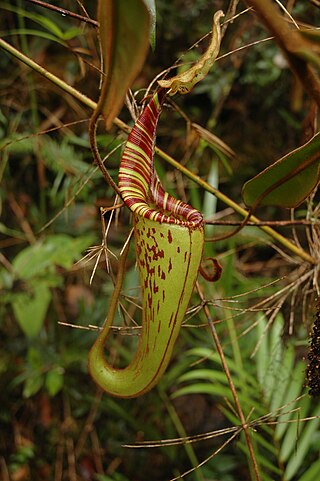
Nepenthes hurrelliana is a tropical pitcher plant endemic to Borneo, where it has been recorded from northern Sarawak, southwestern Sabah, and Brunei. It is of putative hybrid origin; its two original parent species are thought to be N. fusca and N. veitchii. A thick indumentum of rusty-brown hairs covers the entire plant, a characteristic presumably inherited from the latter.

The Bornean peacock-pheasant is a medium-sized pheasant. It is probably the rarest and certainly the least known of all peacock-pheasants. This elusive bird is endemic to lowland forests of Borneo.
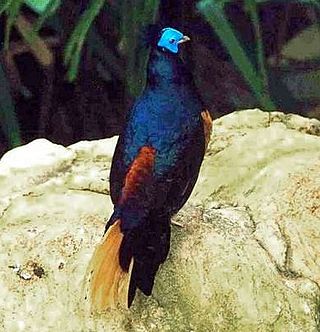
The Bornean crested fireback is a medium-sized forest pheasant from Borneo and the Bangka Belitung Islands. It is the type species of the genus Lophura. Prior to 2023, it was referred to as simply the crested fireback as the Malayan crested fireback was lumped with this species, though both have since been split.
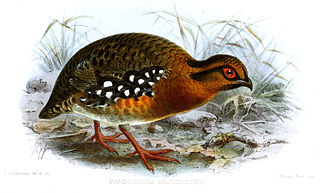
The red-breasted partridge, also known as the Bornean hill-partridge, is a species of bird in the family Phasianidae. It is endemic to hill and montane forest in Borneo, preferring bamboos and thickets. The International Union for Conservation of Nature (IUCN) has assessed it as a least-concern species.
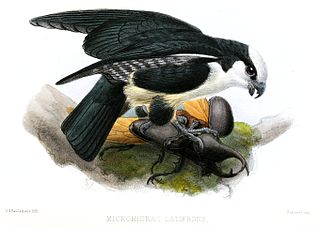
The white-fronted falconet, also called the Bornean falconet, is a species of bird of prey in the family Falconidae. Described by the British ornithologist Richard Bowdler Sharpe in 1879, it is endemic to Borneo, where it is found in Sarawak, Sabah, and extreme northeastern Kalimantan. An extremely small falcon, it is only 14–17 cm (5.5–6.7 in) long and weighs 35–65 g (1.2–2.3 oz), being the smallest species of falconet. It has glossy bluish-black upperparts, black flanks and outer thighs, and a black mask. The belly and vent are pale yellowish-brown, while the throat, cheeks, and breast are white. The species can be told apart from other falconets by the colour of its crown and forehead, which is white in males and reddish-brown in females. It has no subspecies.
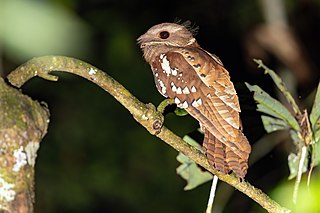
The Dulit frogmouth is a little-known species of bird in the frogmouth family, Podargidae, with a patchily recorded distribution in the mountain forests of northern and central Borneo to which it is endemic. The species is monotypic.

The mountain blackeye, sometimes referred to as the olive blackeye or simply black-eye, is a species of passerine bird in the family Zosteropidae. It is endemic to the highest mountains on the island of Borneo. It is known from both Malaysian states on the island, and four of the five Indonesian provinces, but has never been recorded in Brunei. Typically found at elevations above 1,800 m (5,900 ft), the mountain blackeye sometimes moves to lower altitudes during periods of drought. There are four subspecies, which show clinal variations in size and coloring. Birds in the north are largest, darkest, and proportionately longer-tailed, while those further south are smaller, paler, and proportionately shorter-tailed. Adults are dark olive-green with a sharply-pointed, bright yellow-orange bill and a small dark mask connecting black lores with a black eye-ring. The subspecies show varying amounts of yellow in their plumage, particularly on the face and underparts. Young birds resemble their parents, but have less brightly colored bills.

The Bornean leafbird, also known as the Kinabalu leafbird, is a species of bird in the family Chloropseidae. It is found in humid forest in Borneo, to which it is endemic. It has traditionally been considered a subspecies of the blue-winged leafbird, but differ in measurements and morphology, the female Bornean leafbird having a distinctive male-like plumage. The distribution of the two are known to approach each other, but there is no evidence of intergradation.

The black-sided flowerpecker, also known as the Bornean flowerpecker, is a species of bird in the family Dicaeidae. It is endemic to the island of Borneo, where it is found in the mountains, primarily above 1,000 m (3,300 ft) in elevation. The species is sexually dimorphic. The male has glossy blue-black upperparts, with a scarlet throat and breast, a dark grey upper belly, olive flanks, a white lower belly, and a buffy vent and undertail coverts. The female is olive-green above and greyish below, with buffy flanks and a whitish throat. It inhabits a range of forest habitats, including primary and secondary montane forest, kerangas forest, and scrub, and is also occasionally found in gardens. It feeds primarily on small fruits—particularly mistletoe berries—as well as seeds, nectar, and various invertebrates. It builds a nest of moss, camouflaged on the outside with lichens and lined with the pith of tree ferns. The International Union for Conservation of Nature rates it as a species of least concern. Though its numbers have not been quantified, the black-sided flowerpecker is said to be common throughout much of its range, and any declines are not thought to be precipitous. However, destruction of forest for palm plantations may impact it.
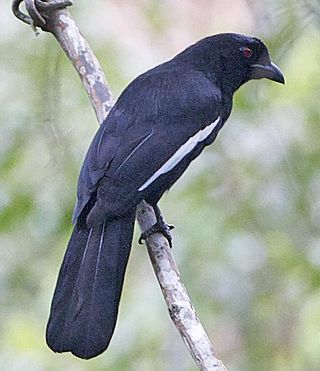
The Malayan black magpie is a species of bird in the family Corvidae. Despite its name, it is neither a magpie nor, as was long believed, a jay, but a treepie. Treepies are a distinct group of corvids externally similar to magpies.

Platysmurus is a genus of treepie in the family Corvidae.

Prevost's squirrel or Asian tri-colored squirrel is a colourful species of rodent in the family Sciuridae. It is found in forests in the Thai-Malay Peninsula, Sumatra, Borneo and nearby smaller islands, with an introduced population in northern Sulawesi. Although the Prevost's squirrel is declining in some regions because of habitat loss and hunting, the species is not considered threatened since it generally remains common and widespread. It can live in somewhat disturbed habitats and often visits plantations or gardens. It mostly feeds on plant material, especially fruits, but also takes insects.

The Bornean treepie is a passerine bird belonging to the treepies genus, Dendrocitta, of in the crow family, Corvidae. It is endemic to the island of Borneo. It is sometimes treated as a subspecies of the Sumatran treepie.
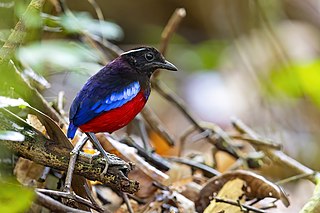
The black-crowned pitta, also known as the black-headed pitta, black-and-crimson pitta, black-and-scarlet pitta or black-crowned garnet pitta, is a brightly coloured, ground-dwelling, bird species in the pitta family. It is endemic to the Southeast Asian island of Borneo. It was described by John Gould in 1877, with the type locality recorded as the Lawas River in northern Sarawak.

The Bornean bulbul is a member of the bulbul family of passerine birds. It is endemic to the island of Borneo.

The Dulit partridge, also known as Hose's partridge, has been considered a distinctive subspecies of the long-billed partridge, a bird in the Phasianidae, or pheasant, family. It is endemic to Borneo, where it appears to be separated altitudinally from the nominate subspecies, and is often considered now to be a full species, Rhizothera dulitensis. It is little-known, rare, and has not been recorded since 1937.
The Bornean swiftlet, also referred to as the Kinabalu 'linchi' swiftlet, is a small bird in the swift family Apodidae. It is endemic to the northern mountains of the island of Borneo. It has variously been considered a subspecies of the glossy swiftlet or the cave swiftlet, and in 2008 was split from the latter as a full species C. dodgei.

















